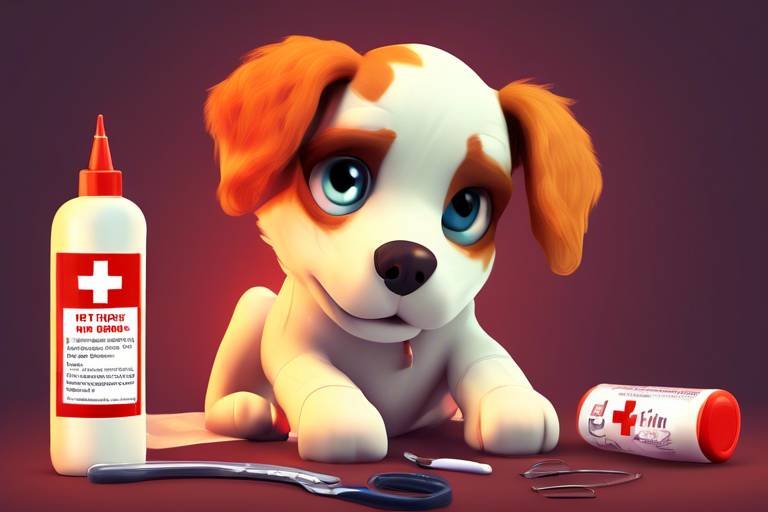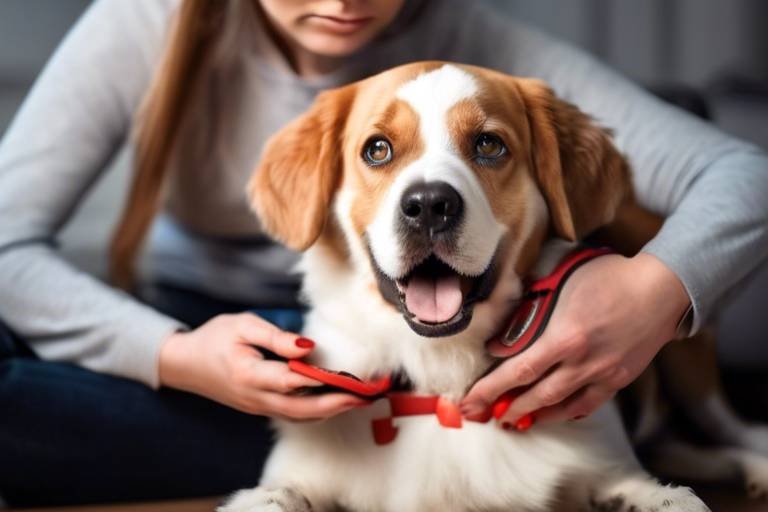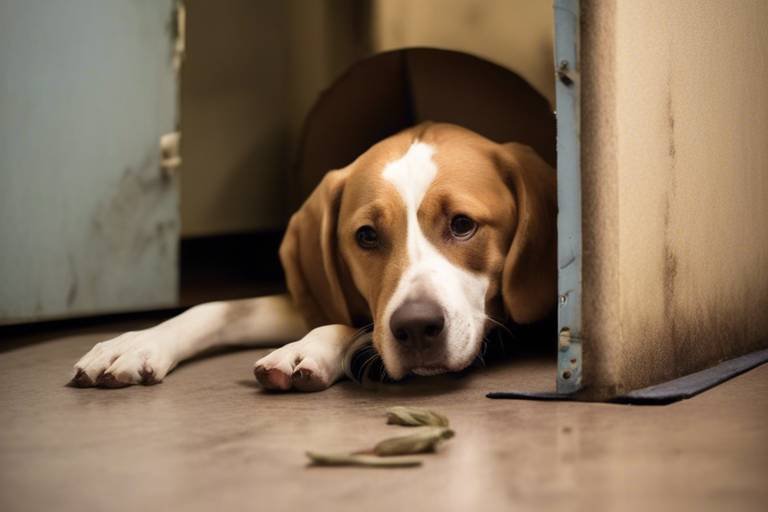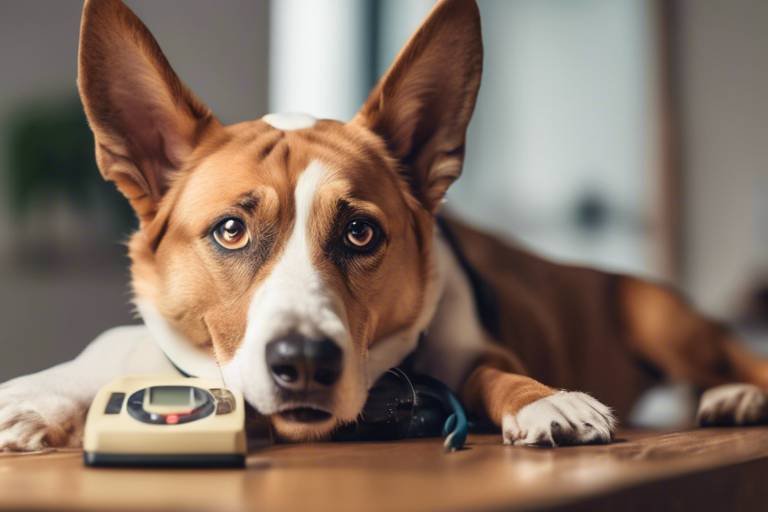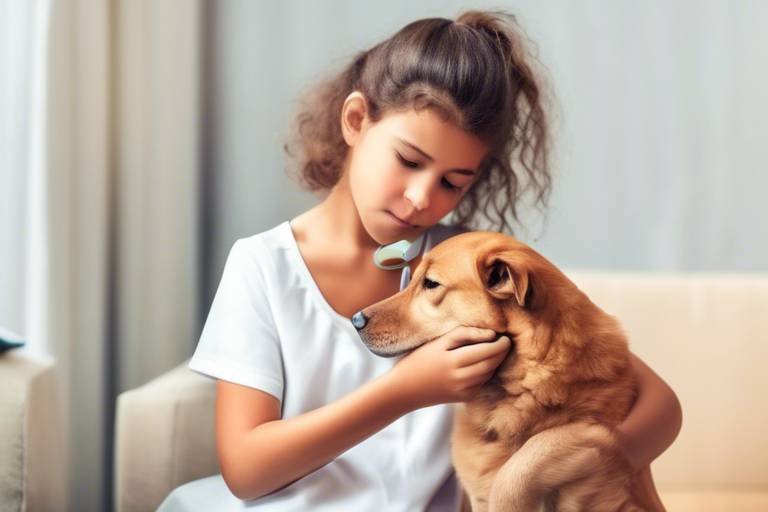How to Prepare for a Pet Emergency at Home
As a pet owner, the safety and well-being of your furry companions are undoubtedly among your top priorities. But what happens when the unexpected strikes? Emergencies can come in many forms, from natural disasters to sudden health crises, and being prepared can make all the difference. Imagine this: it's a calm afternoon, and suddenly, a storm hits, or your pet ingests something toxic. In these moments, having a plan can mean the difference between panic and a well-coordinated response. This article provides essential tips and strategies for pet owners to effectively prepare for emergencies, ensuring the safety and well-being of their beloved pets during unexpected situations.
Familiarizing yourself with the most frequent types of pet emergencies can help you respond quickly. Emergencies can vary widely, but some of the most common include injuries from accidents, poisoning from household items, and sudden illnesses that may require immediate veterinary attention. For instance, did you know that certain plants are toxic to pets? If your furry friend accidentally munches on one, you’ll need to act fast. Understanding these scenarios not only prepares you mentally but also equips you with the knowledge to handle them effectively. Here are some typical emergencies to be aware of:
- Injuries: Cuts, bites, or broken bones can occur during playtime or accidents.
- Poisoning: Common household items like chocolate, certain plants, and medications can be harmful.
- Sudden Illnesses: Conditions like bloat or seizures require immediate care.
An emergency kit is crucial for any pet owner. Imagine being in a situation where you need to grab your pet and go, but you don’t have the essentials at hand. It’s a stressful thought, isn’t it? To avoid this, outline the essential items to include in your kit. This kit should contain first-aid supplies, food, water, and medications, ensuring your pet's needs are met in a crisis. Here’s a quick snapshot of what to include:
| Item | Description |
|---|---|
| First-Aid Supplies | Bandages, antiseptics, and other tools for treating minor injuries. |
| Food | Non-perishable pet food that lasts for an extended period. |
| Water | Clean water stored in a safe and accessible container. |
| Medications | Your pet’s regular medications and any necessary prescriptions. |
Learn about the specific first-aid items necessary for treating minor injuries or ailments in pets. Having the right supplies can make a world of difference when time is of the essence. Essential items to keep on hand include:
- Gauze and bandages for cuts and scrapes.
- Antiseptic wipes or solutions to clean wounds.
- Thermometer for checking your pet's temperature.
- Tweezers for removing splinters or ticks.
Understanding your pet's medications and appropriate dosages is vital. You wouldn’t want to give your pet the wrong amount in a stressful situation. Organizing and storing medications safely for quick access during an emergency is crucial. Consider creating a list that includes:
- The name of the medication
- The dosage
- Instructions for administration
Keep this list in your emergency kit along with the medications so you can grab everything in one go.
Ensuring your pet has enough food and water is essential during an emergency. Store supplies properly to avoid spoilage, and consider having a backup plan in case your usual supply runs out. It’s also wise to rotate your food supplies regularly to keep them fresh. Remember, just like us, pets need hydration, especially during stressful situations. Aim for at least a three-day supply of both food and water.
Training your pet to respond to emergency situations can save lives. Imagine your dog calmly following your commands during a chaotic moment. This can be achieved through consistent training techniques that condition pets to follow commands and stay calm during stressful events. Start with basic commands and gradually introduce more complex ones. Regular practice can help your pet feel more secure and responsive when it matters most.
Having a well-thought-out emergency plan is essential for pet safety. This plan should include evacuation routes, safe locations, and communication strategies. Think about where you would go if you had to evacuate quickly and how you would transport your pet. Discussing these details with your family ensures everyone knows their roles and responsibilities in an emergency.
Identifying safe locations for your pet during an emergency is crucial. Research pet-friendly shelters and resources available in your community. Make a list of these places and keep it in your emergency kit. Knowing where to go can alleviate stress when time is of the essence.
Effective communication is key in emergencies. Discussing your emergency plan with family members ensures everyone knows their roles and responsibilities. Regularly review the plan and make adjustments as necessary. This proactive approach can help everyone feel more prepared and less anxious when an emergency arises.
Q: What should I do if my pet is injured?
A: Stay calm, assess the injury, and apply first-aid if necessary. If it’s serious, contact your vet immediately.
Q: How can I tell if my pet is poisoned?
A: Symptoms may include vomiting, diarrhea, or lethargy. If you suspect poisoning, contact your vet right away.
Q: How often should I update my emergency kit?
A: Regularly check your kit every few months to ensure food, water, and medications are fresh and up to date.
Q: Can I train my pet to stay calm during emergencies?
A: Yes! Consistent training and positive reinforcement can help your pet respond better in stressful situations.

Understanding Common Pet Emergencies
As a pet owner, nothing is more heart-wrenching than the thought of your furry friend facing an emergency. But just like we prepare for unexpected situations in our lives, we must also be ready for our pets. Understanding the common types of pet emergencies is the first step in ensuring their safety and well-being. Imagine you’re enjoying a sunny day at the park, and suddenly your pup gets into something toxic or injures itself. How would you react? Would you know what to do? Familiarizing yourself with these scenarios can make all the difference.
Some of the most frequent types of pet emergencies include:
- Injuries: These can range from minor cuts and scrapes to more severe wounds that require immediate veterinary attention. Pets can easily get hurt while playing or exploring their environment.
- Poisoning: This is a serious concern, as pets are often curious and may ingest harmful substances. Common household items like chocolate, certain plants, and cleaning products can be toxic.
- Sudden Illnesses: Conditions such as bloat, seizures, or respiratory distress can occur without warning. Recognizing the signs early can be crucial for your pet's survival.
Each of these emergencies requires a different response, and knowing how to act quickly can save your pet's life. For instance, if your dog ingests something toxic, time is of the essence. You might need to induce vomiting or rush them to the vet. Similarly, if your pet suffers an injury, having a basic understanding of first-aid can help you stabilize them until professional help is available.
Moreover, it’s essential to keep an eye on your pet’s behavior. Are they acting differently? Are they lethargic or refusing food? These could be signs of an underlying issue that needs immediate attention. Just like us, pets can’t always communicate their discomfort, so being observant is key.
In conclusion, understanding common pet emergencies is not just about knowing what can happen; it’s about being proactive. Equip yourself with knowledge and resources, and you’ll be better prepared to handle any situation that may arise. Remember, the goal is to keep your furry companions safe and sound, and a little preparation goes a long way!

Creating a Pet Emergency Kit
When it comes to our furry friends, being prepared is not just a good idea; it’s a necessity. Imagine a scenario where disaster strikes—be it a natural calamity, sudden illness, or an unexpected accident. The last thing you want is to scramble around, trying to gather supplies while your pet is in distress. That’s why creating a Pet Emergency Kit is crucial. This kit should be a well-organized collection of essential items that can help you respond swiftly and effectively to any emergency situation involving your pet.
First and foremost, let’s talk about the basics. Your emergency kit should include items that cater to your pet’s immediate needs. Think of it as a lifeline for your furry companion. Here are some fundamental components to consider:
- First-Aid Supplies: Just like humans, pets can get injured too. Having a first-aid kit specifically designed for pets can make a world of difference. This kit should include bandages, antiseptic wipes, tweezers, and a digital thermometer.
- Food and Water: Ensure you have at least a three-day supply of your pet’s food and water. It’s essential to pack this in airtight containers to keep them fresh.
- Medications: If your pet is on any medication, include a sufficient supply along with a list of dosages. This can be a lifesaver during emergencies.
Now, let’s focus on the first-aid supplies in more detail. Not all injuries are severe, but having the right tools can help you manage minor wounds effectively. For example, a simple cut can become infected if not treated properly. Therefore, your first-aid kit should contain:
| Item | Purpose |
|---|---|
| Bandages | To cover wounds and prevent infection. |
| Antiseptic Wipes | To clean wounds before applying bandages. |
| Tweezers | To remove splinters or ticks. |
| Digital Thermometer | To check for fever in pets. |
Having a well-stocked kit is fantastic, but it’s equally important to know how to use these supplies. Take some time to familiarize yourself with basic pet first-aid techniques. There are numerous online resources and courses that can equip you with the knowledge to handle emergencies like a pro. Remember, in a crisis, every second counts!
Another crucial aspect of your emergency kit is the storage of medications. It’s not enough to just have them on hand; you need to organize them in a way that allows for quick access. Consider using a waterproof container to store your pet's medications, along with clear labels indicating the name of the medication, dosage, and administration instructions. This will save precious time in a stressful situation.
Food and water are non-negotiables in your emergency kit. Make sure to rotate your supplies regularly to ensure they remain fresh. You can also include a portable water bowl and a few treats to keep your pet calm during stressful times. If your pet has dietary restrictions, plan accordingly and include alternative food sources that meet their needs.
In conclusion, preparing a Pet Emergency Kit is an essential step every pet owner should take. By being proactive, you can ensure that your beloved companion has everything they need during a crisis. It’s not just about having the supplies; it’s about having peace of mind knowing you’re ready for anything that comes your way.
First-Aid Supplies for Pets
When it comes to our furry friends, being prepared is not just a good idea—it's a necessity! Imagine your pet getting a cut while playing outside or having a sudden allergic reaction. These situations can be stressful, but having a well-stocked first-aid kit can make all the difference. So, what exactly should you include in your pet's first-aid supplies? Let’s dive into the essentials that every pet owner should have on hand.
First and foremost, you’ll want to include bandages of various sizes. These are crucial for covering wounds and preventing further injury. Think of them as your pet's protective armor in times of need! Additionally, having antiseptic wipes or solutions is vital for cleaning wounds and preventing infections. Just like we wouldn’t want to ignore a scrape, our pets deserve the same level of care.
Another important item is gauze pads, which can be used to wrap larger injuries or to absorb any bleeding. Alongside these, you should also consider adding a thermometer specifically designed for pets. A quick temperature check can help you gauge whether your pet is running a fever or if something more serious is going on. It’s like having a mini doctor kit at home!
Don’t forget about tweezers and scissors. Tweezers can help remove splinters or ticks, while scissors can be used to cut away matted fur or clothing if necessary. Think of them as your trusty sidekicks during emergencies. And for those pets prone to allergies, having a supply of antihistamines can be a lifesaver. Just be sure to consult your veterinarian for the right type and dosage for your pet.
In addition to these items, it’s wise to include a muzzle in your kit. It may sound counterintuitive, but even the sweetest pets can bite when they’re in pain. A muzzle ensures safety for both you and your pet during a stressful situation. Lastly, consider adding a pet first-aid manual to your kit. This can serve as your go-to guide for various emergencies, providing quick instructions when every second counts.
To summarize, here’s a quick table of essential first-aid supplies for your pets:
| Item | Purpose |
|---|---|
| Bandages | To cover and protect wounds |
| Antiseptic wipes | To clean wounds and prevent infection |
| Gauze pads | For wrapping larger injuries |
| Thermometer | To check for fever |
| Tweezers | To remove splinters or ticks |
| Antihistamines | For allergic reactions |
| Muzzle | To prevent biting during emergencies |
| Pet first-aid manual | For quick reference in emergencies |
By taking the time to prepare a comprehensive first-aid kit for your pet, you’re not just being practical; you’re showing love and responsibility. Remember, emergencies can happen at any moment, and being ready can save your pet’s life. So, gather these supplies, keep them in an easily accessible location, and rest easy knowing you’re prepared for whatever comes your way!
Medications and Dosages
When it comes to your pet's health, understanding their medications and the correct dosages is absolutely crucial. Just like us, pets can face a variety of health issues that may require medication, from chronic conditions to sudden illnesses. As a responsible pet owner, you need to be prepared for these situations by knowing what medications your pet takes, why they take them, and how much they should be given. This knowledge not only ensures that your furry friend receives the right treatment but also helps you avoid any potential overdoses or adverse reactions that could arise from incorrect dosages.
First things first, it’s essential to keep an organized record of your pet's medications. A simple way to do this is by creating a medication chart that includes the following information:
| Medication Name | Dosage | Frequency | Reason for Use |
|---|---|---|---|
| Example: Amoxicillin | 250 mg | Twice a day | Infection |
| Example: Prednisone | 5 mg | Once a day | Allergy |
Having this information readily available can be a lifesaver, especially in an emergency. Make sure to update the chart whenever your pet's medications change or when you receive new prescriptions from your veterinarian. It's also a good idea to keep a copy of this chart in your emergency kit, so you have it on hand when you need it most.
Additionally, understanding how to administer medications correctly is vital. Some pets may require pills to be given whole, while others might need them crushed or mixed with food. If your pet is particularly fussy, consider talking to your vet about alternatives like liquid medications or flavored tablets. Always follow your veterinarian's instructions when it comes to administering medications, as they know your pet's specific needs and can provide tailored advice.
Lastly, be aware of any side effects that might occur with your pet's medications. Just like humans, pets can react differently to drugs, and some may experience adverse effects. If you notice any unusual behavior or symptoms after giving your pet medication, such as vomiting, lethargy, or changes in appetite, contact your veterinarian immediately. Being vigilant about your pet's health can make all the difference in ensuring their safety and well-being.
In conclusion, being well-informed about your pet's medications and dosages is a key component of emergency preparedness. By keeping organized records, knowing how to administer medications, and being aware of potential side effects, you can ensure that your furry companion receives the best possible care in any situation.
- What should I do if I miss a dose of my pet's medication? - If you forget to give a dose, administer it as soon as you remember. However, if it's almost time for the next dose, skip the missed one and continue with the regular schedule. Never give two doses at once without consulting your veterinarian.
- How can I tell if my pet is having a reaction to their medication? - Signs of a reaction can include excessive drooling, vomiting, diarrhea, or unusual behavior. If you notice any of these symptoms, contact your vet immediately.
- Can I give my pet human medications? - Never give your pet human medications without consulting your veterinarian first, as many human medications can be toxic to pets.
Food and Water Provisions
When it comes to ensuring your furry friend’s safety during an emergency, one of the most crucial aspects is having adequate . Imagine being in a situation where you need to evacuate or stay put due to a natural disaster; your pet's well-being hinges on your preparedness. It’s not just about having their favorite kibble on hand; it’s about planning ahead to make sure they have enough sustenance to last through uncertain times.
First and foremost, you should consider storing at least a two-week supply of food and water for your pet. This means calculating how much they consume daily and multiplying that by the number of days you want to be prepared for. For instance, if your dog eats about 2 cups of food a day, then you should have at least 28 cups of food ready to go. Don’t forget to factor in any special dietary needs your pet may have. If your pet is on a specific diet, make sure to stock up on that particular food to avoid any digestive issues during a stressful time.
Water is equally important, if not more so. A good rule of thumb is to have at least one gallon of water per pet, per day. This means for a two-week supply, you would need a minimum of 14 gallons for your furry companion. Storing water in sturdy, sealed containers will ensure it stays fresh. Additionally, consider including a portable water bowl in your emergency kit, as this will make it easier to hydrate your pet on the go.
Another consideration is the storage of these provisions. Make sure to keep them in a cool, dry place to prevent spoilage. Regularly check the expiration dates on food and rotate your supplies as needed. It’s a good idea to create a schedule for checking your emergency supplies, ensuring that everything is up to date and ready when you need it. You might even want to set a reminder on your phone or calendar to do this every few months.
In addition, don’t overlook the importance of having a backup plan for feeding and watering your pet in case you are unable to reach your supplies. Consider sharing the responsibility with a trusted friend or family member who can help care for your pet if you’re not around. Having a buddy system can be a lifesaver!
Lastly, it’s essential to think about the logistics of feeding your pet during an emergency. If you have to evacuate, you might need to bring your pet’s food and water with you. This is where having a pet emergency bag comes in handy. Pack their food, water, bowls, and any other necessary items in a sturdy backpack or tote that’s easy to carry. This way, you’ll have everything ready to go at a moment’s notice.
By taking the time to prepare your food and water provisions, you’re not just ensuring your pet's survival; you’re also providing them with a sense of comfort during a chaotic time. Remember, a well-fed and hydrated pet is a happy pet, even in the face of emergencies!
Training Your Pet for Emergencies
When it comes to keeping our furry friends safe, is not just a good idea—it's a necessity! Imagine a situation where chaos reigns, and you need your pet to respond quickly and calmly. This is where training comes into play. Just like teaching a child to react appropriately in a fire drill, your pet can learn to navigate emergency situations with the right guidance.
Start by introducing basic commands such as "sit," "stay," and "come." These commands are essential, as they can help you manage your pet during stressful situations. For instance, if you need to evacuate your home, a simple command can keep your pet by your side rather than darting off in panic. It’s crucial to practice these commands in various environments, so your pet becomes accustomed to responding regardless of distractions.
Moreover, consider simulating emergency scenarios. This could involve creating a mock evacuation where you guide your pet through an escape route. Use treats and positive reinforcement to encourage them to follow your lead. The goal is to make the experience feel safe and rewarding, rather than frightening. Remember, pets are incredibly perceptive, and they can pick up on your emotions. If you remain calm and collected, they are more likely to mirror that behavior.
Another important aspect is desensitization. If your pet is fearful of loud noises, such as thunder or fireworks, it’s essential to expose them to these sounds gradually. Play recordings of these noises at a low volume while providing treats and praise. Over time, your pet will learn that these sounds are not a cause for alarm, helping them remain calm during actual emergencies. You could even create a safe space in your home where they can retreat during stressful times, filled with their favorite toys and blankets.
In addition to training, consider enrolling your pet in a basic obedience class. These classes not only teach essential skills but also provide socialization opportunities with other pets and people. This exposure can help your pet feel more comfortable in various situations, which is invaluable during an emergency.
Lastly, it’s essential to keep your pet’s identification up to date. Ensure they have a collar with an ID tag that includes your contact information. Microchipping is also a great option, as it provides a permanent form of identification. In the event that you become separated during an emergency, having a way to reunite with your pet can make all the difference.
In conclusion, is about preparation, patience, and positivity. By taking the time to teach your pet how to respond to unexpected situations, you are not only ensuring their safety but also fostering a deeper bond between you and your furry companion. After all, a well-trained pet is a happy pet, especially when it comes to navigating the unpredictability of life!
- How can I start training my pet for emergencies? Begin with basic commands and gradually introduce emergency scenarios using positive reinforcement.
- What if my pet is fearful of loud noises? Gradual exposure to these sounds and creating a safe space can help desensitize them.
- Is it necessary to microchip my pet? Yes, microchipping provides a permanent form of identification that can help reunite you with your pet in case of separation.

Developing an Emergency Plan
When it comes to keeping our furry friends safe, having a well-thought-out emergency plan is absolutely essential. Think of it as a roadmap that guides you through the chaos of an unexpected situation. Just like you wouldn’t head out on a road trip without a map, you shouldn’t face an emergency without a solid plan in place. So, where do you start? First, consider the types of emergencies that might occur in your area. Whether it's a natural disaster like a hurricane or an unexpected fire, knowing what could happen helps you prepare accordingly.
Next, it’s crucial to identify evacuation routes. Picture this: a sudden storm hits, and you need to leave your home quickly. Do you know the fastest way to get to safety with your pet? Take the time to map out at least two different routes to your safe location. This way, if one route is blocked, you have a backup. Additionally, look into pet-friendly shelters or hotels in your area. Not all places accept pets, so having a list of options can save you a lot of stress during an emergency.
Another vital aspect of your emergency plan is communication. It’s not just about you knowing the plan; everyone in your household must be on the same page. Hold a family meeting to discuss the plan. Make sure each person knows their role. For example, if you have kids, assign them tasks, like grabbing the pet’s emergency kit or helping to secure the house. This not only ensures everyone knows what to do but also helps to keep them calm during a stressful situation.
To further assist you in developing your emergency plan, consider creating a simple table to keep track of important information:
| Emergency Type | Evacuation Route | Safe Location | Contact Information |
|---|---|---|---|
| Fire | Main Road, 2nd Avenue | Local Pet Shelter | (555) 123-4567 |
| Flood | Highway 10, Exit 2 | Friends' House | (555) 987-6543 |
| Earthquake | Back Road, North Exit | Community Center | (555) 456-7890 |
As you develop your plan, don’t forget to include your pet's needs. Make a checklist of what to bring, such as food, water, medications, and any comfort items like their favorite toy or blanket. In the heat of the moment, it’s easy to forget these essentials, so having a prepared checklist can be a lifesaver.
In summary, developing an emergency plan for your pet is all about preparation and communication. By taking the time to create a comprehensive plan, you can ensure that you and your furry friend are ready to face any unexpected situation with confidence and ease. After all, in the world of pet ownership, it’s better to be safe than sorry!
Q: How often should I review my emergency plan?
A: It's a good idea to review your emergency plan at least once a year or whenever there are significant changes in your household or environment.
Q: What should I do if my pet is scared during an emergency?
A: Keep calm and reassure your pet. Familiar items like toys or blankets can help soothe them. Training your pet to respond to commands can also help manage their anxiety.
Q: Are there pet insurance options that cover emergencies?
A: Yes, many pet insurance policies cover emergency care. Make sure to read the fine print to understand what is included.
Identifying Safe Locations
When disaster strikes, knowing where to take your pet for safety can be a game changer. Imagine a scenario where you have to evacuate your home due to a natural disaster like a flood or wildfire. The last thing you want is to be scrambling for a safe place that can accommodate both you and your furry friend. That's why it’s crucial to identify safe locations ahead of time, ensuring that you and your pet are prepared for any situation that may arise.
First and foremost, start by researching pet-friendly shelters in your area. Many communities have designated shelters that allow pets during emergencies. You can typically find this information on your local government’s website or by contacting your local animal control. It’s a good idea to have a list of these locations handy, so you can quickly refer to it during an emergency. Here’s a simple table to help you keep track:
| Location Name | Address | Contact Number | Pet Policy |
|---|---|---|---|
| City Shelter | 123 Pet Lane | (555) 123-4567 | Pets allowed with proof of vaccination |
| Community Center | 456 Safe St. | (555) 987-6543 | Limited space for pets |
Additionally, consider reaching out to friends or family who live nearby. Having a list of contacts who are willing to help can provide peace of mind. Perhaps a neighbor has a large backyard or a friend has a spacious home that can accommodate both you and your pets. Open communication with these individuals can make a huge difference when time is of the essence.
Also, don't forget to check for local hotels or motels that allow pets. In case of an emergency that forces you to leave your home, knowing where you can find temporary housing for you and your pet is invaluable. Make a quick call to these places to confirm their pet policies and any fees that may apply. You wouldn’t want to be caught off guard when you need a safe haven!
Lastly, familiarize yourself with your neighborhood. Identify open spaces like parks or community centers that could serve as temporary refuge areas if necessary. In a pinch, these locations can provide a sense of security and a place to regroup. Just remember, the key is to plan ahead. By being proactive and doing your homework now, you can ensure that you’re not left scrambling when an emergency occurs.
Q: What should I include in my emergency pet plan?
A: Your emergency pet plan should include safe locations, contact information for pet-friendly shelters, and a list of friends or family who can help.
Q: How can I prepare my pet for an evacuation?
A: Get your pet used to their carrier or travel crate, and practice short trips to make them comfortable with the process.
Q: Are there any apps that can help during emergencies?
A: Yes! There are several apps available that provide information on pet-friendly shelters and emergency resources. Consider downloading one before an emergency arises.
Communicating with Family Members
When it comes to pet emergencies, communication is key. Imagine a scenario where chaos reigns: your pet is injured, and everyone in the household is in a state of panic. Without a clear plan, things can quickly spiral out of control. This is why discussing your emergency plan with family members is not just important; it’s essential. Start by gathering everyone in a calm setting and explain the potential emergencies that could arise. Use real-life examples to make it relatable. For instance, you might say, “What if there’s a fire, and we need to evacuate quickly? We need to know how to safely get Fluffy out too!”
Next, assign specific roles to each family member. This can help ensure that everyone knows exactly what to do in a crisis, reducing confusion and anxiety. For example, you might have one person responsible for grabbing the emergency pet kit, while another checks on the pet's safety. It's also a good idea to create a visual aid or a simple chart that outlines these roles and responsibilities. You could even use a whiteboard or a poster in a common area of the house. This way, if an emergency strikes, everyone can quickly refer to it.
Additionally, consider setting up a family meeting to practice your emergency plan. Role-playing can be an effective way to prepare everyone for real-life situations. You could simulate an emergency by setting a timer and having family members act out their roles. This not only helps reinforce the plan but also allows everyone to feel more confident and less anxious when an actual emergency occurs.
In your discussions, make sure to cover the following points:
- Evacuation Routes: Identify the quickest paths to safety that accommodate both humans and pets.
- Safe Locations: Know where the nearest pet-friendly shelters are located.
- Communication Methods: Establish how you will contact each other if separated.
Lastly, don’t forget to include your children in these discussions. Teaching them about pet safety and emergency preparedness not only empowers them but also reinforces the importance of taking care of their furry friends. Encourage them to ask questions and express any concerns they might have. This open line of communication fosters a sense of teamwork and responsibility within the family.
Q1: What should I do if my pet gets injured during an emergency?
A1: Remain calm and assess the injury. If it’s serious, contact your veterinarian immediately or take your pet to the nearest emergency clinic. Having a first-aid kit handy can help you manage minor injuries on the spot.
Q2: How can I ensure my pet is comfortable during an emergency?
A2: Familiarize your pet with the emergency kit and practice evacuation drills. Having their favorite toys or blankets can also help soothe them during stressful situations.
Q3: What if I have to leave my pet behind during an evacuation?
A3: Always try to take your pet with you. If it’s absolutely impossible, leave them with sufficient food, water, and a safe environment. Inform your neighbors or local shelters about your pet’s situation.
Frequently Asked Questions
- What should I do if my pet gets injured?
If your pet gets injured, the first step is to assess the situation calmly. Check for bleeding or visible wounds, and if necessary, apply a clean bandage. It's crucial to contact your veterinarian immediately for further advice and treatment. Always keep your pet calm and avoid any unnecessary movement to prevent aggravating the injury.
- How can I tell if my pet has been poisoned?
Signs of poisoning in pets can vary but often include vomiting, diarrhea, lethargy, or seizures. If you suspect your pet has ingested something toxic, contact your veterinarian or an emergency animal poison control hotline right away. Quick action can be lifesaving!
- What items should be included in a pet emergency kit?
Your pet emergency kit should include essential items such as a first-aid kit, a supply of food and water, medications, a leash, and any necessary documents like vaccination records. Don't forget to add comfort items like a favorite toy or blanket to help soothe your pet during stressful times.
- How can I train my pet for emergencies?
Training your pet for emergencies involves teaching them basic commands like "come," "stay," and "leave it." Practice these commands in various situations to ensure they remain calm and responsive during stressful events. Regular drills can also help them get used to the idea of evacuating or following your lead in an emergency.
- What should be included in my emergency plan for pets?
Your emergency plan should outline evacuation routes, safe locations for your pet, and a communication strategy with family members. Make sure everyone knows what to do and where to go in case of an emergency. Having a well-structured plan can make all the difference when every second counts!
- Where can I find pet-friendly shelters during an emergency?
To find pet-friendly shelters during an emergency, check local government websites or community resources that provide information on emergency services. It's a good idea to have a list of these shelters handy, so you can act quickly if needed.
- How can I communicate the emergency plan to my family?
Discuss your emergency plan with your family during a calm moment, ensuring everyone understands their roles and responsibilities. You might even want to practice the plan together, so everyone feels confident and prepared. Clear communication is key to ensuring your pet's safety during an emergency!


